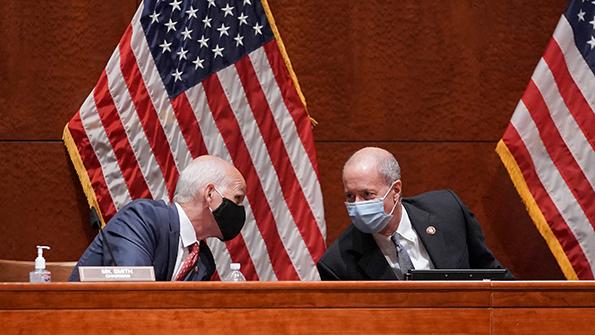
I am surprised by the vigorous hand-wringing this summer over the prospects for defense spending in a Democratic-dominated government beginning in January 2021. There’s every indication that the Democrats who may come to office next year with meaningful power over defense budgets subscribe to a bipartisan consensus that defense spending is leveling off in real terms, just as planned in the Trump administration’s defense program for 2021-25. Recent indications to the contrary are misleading; worse, they distract from what matters much more about this year’s election and the outlook for defense spending.
Last month’s partisan rancor over the Defense Department’s budget has come to naught. On the left, the amendments of Sen. Bernie Sanders (I-Vt.) and Rep. Mark Pocan (D-Wis.) that would have reduced by 10% the national defense authorization for 2021 were defeated by wide bipartisan majorities, which would have been still larger but for the implausibility of the motions’ passage. From the right, off-the-record “experts” raising alarm among investors about imagined plans to reduce the annual Pentagon budget to $550 billion—an implied rate of reduction not seen since the end of the Korean War—succeeded only in reminding us of how easily rank expediency sometimes passes for insight on Wall Street.
By contrast, the summer’s telling indicator of the outlook for defense spending lies instead in the strikingly bipartisan $740 billion defense authorization bill that Rep. Adam Smith (D-Wash.) brought to the House floor. Not only did the bill receive a 56-0 vote out of the Armed Services Committee, but Smith, the committee’s chairman, also chose to name it in honor of the committee’s retiring ranking member, Rep. Mac Thornberry (R-Texas).
More to the point, it is hard to find anything in the views of former Vice President Joe Biden and his campaign advisors—or of the Democrats who lead defense committees on Capitol Hill—to suggest they harbor plans to reset the defense budget outlook. Politico even associated Biden with the slogan “Boost the defense budget” in its tally of presidential candidates’ positions. What one does find among Democratic views of defense policy, however, is a conviction that China poses a strategic challenge to U.S. interests, the essential premise of today’s historically high peacetime defense budgets but a view that stands in clear contrast to President Donald Trump’s ambivalence over China’s military-strategic importance and his peculiar admiration for President Xi Jinping.
The defense budget is not impervious to our fraught politics and economy, but no political realignment that could deflect today’s bipartisan consensus on U.S. defense spending is likely to emerge before the midterm elections of 2022. If the next administration and Congress fail quickly to stanch the health and economic catastrophe of the coronavirus pandemic, a progressive wave could well roll into Congress in January 2023 with a platform that prioritizes Americans’ at-home lives and livelihoods over the U.S. leadership role in the world. Or the midterm election could activate revanchist Tea Party sentiment to anchor Republican recalcitrance against Democratic governance with the familiar practice of trading off the Pentagon’s budget to blunt domestic-spending initiatives and contain taxes. Sound familiar? In the five budget years of the Obama presidency after Republicans won control of the House in 2010, the congressional defense appropriations reduced the administration’s budget requests for the Pentagon by a total of $115 billion.
Against the backdrop of today’s bipartisan consensus, the more significant difference about defense spending between the two parties has to do with the prospects for the productivity of those dollars: How much national security can each provide with a $740 billion defense budget? Where Democrats, in the words of former Undersecretary of Defense Michele Flournoy, believe the military-technological competition with China “must be [the Pentagon] leadership’s top priority,” Defense Secretary Mark Esper spent the week he released this year’s defense budget defending the administration’s redirection of $4 billion from the Defense Department’s procurement accounts to fund the president’s border wall. Where Democrats, in the words of Biden’s former National Security Advisor Colin Kahl, would put alliances and partnerships “at the top of the agenda,” Esper recently had to acknowledge that it will cost billions of dollars not currently in the Pentagon budget to redeploy U.S. forces out of Germany in response to Trump’s determination that Germany’s government is “delinquent.” Facing flat budget growth, the Pentagon will require strategic focus, not distraction and ambivalence, and alliance relations that leverage U.S. defense spending, not compound its costs.
If any hand-wringing is worth doing about politics and defense spending, it would be better put toward building calluses against the hard work of increasing the productivity of defense dollars than polishing old chestnuts about how Democrats are soft on defense.
Contributing columnist Steve Grundman is principal of the consultancy Grundman Advisory and senior fellow at the Atlantic Council.
The views expressed are not necessarily those of Aviation Week.




